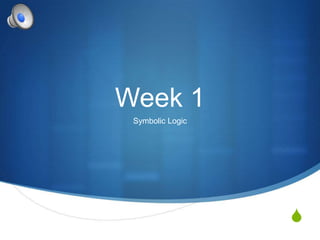
Chapter 1
- 1. Week 1 Symbolic Logic S
- 2. Review from first class S Argument S An argument is a series of sentences. S Sentence S A sentence is something that can be true or false. S Premises S Intended to support another sentence (reasons) – the first sentences in the series. S Conclusion S The sentence supported by the others in the series.
- 3. A way of representing arguments: standard form S Premises first and then the conclusion It is going to rain today. Whenever it rains the streets get slippery. he streets will get slippery. means “therefore” and indicates the conclusion of the argument.
- 4. Two ways in which an argument can go wrong S One or more of the premises might be false. S The premises might fail to support the conclusion. S If either (or both) of these happen then the argument will be weak (the argument will not be a good one). S Good arguments are strong arguments. S Strong deductive argument = true premises + deductively valid.
- 5. Thinking about deductive validity 1. Can an deductively valid argument have true premises and a true conclusion? 2. Can a deductively valid argument have true premises and a false conclusion? 3. Can a deductively valid argument have a false premise and a true conclusion? 4. Can a deductively valid argument have all false premises and a true conclusion?
- 6. 5. Can a deductively valid argument have false premises and a false conclusion? 6. Can a strong argument have false premises and a false conclusion? 7. Can a strong argument have false premises and true conclusion? 8. Can a strong argument have true premises and a false conclusion? 9. If an argument has true premises and a true conclusion can it be weak?
- 7. Logical possibility S Modalities S Necessity S Possibility S Actuality S Probability S Impossibility
- 8. Other logical notions from Chapter 1 S Truth-values S True or false are said to be the truth-values of a sentence. S Tautology (logical truth) S A sentence that is true as a matter of logic. It is not possible for it to be false. It is true regardless of what the world is actually like. S Contradiction (logical falsehood) S A sentence that is false as a matter of logic. It is not possible for it to be true. It is false regardless of what the world is actually like.
- 9. S Contingent sentence S A sentence that is neither a tautology nor a contradiction. Its truth is dependent on something other than logic. S Logical equivalence S Two sentences that necessarily have the same truth-value are logically equivalent. S Consistency S A set of sentences is consistent if it is logically possible for them all to be true at the same time. If it is not possible for them all to be true at the same time they are inconsistent.
- 10. Formal languages vs. Natural Languages S The idea that sentences (and consequently arguments) have a form. All men are mortal. Socrates is a man. Socrates is mortal.
- 11. All philosophy professors are brilliant. Dr. Crasnow is a philosophy professor. Dr. Crasnow is brilliant. S Probably not strong but it is deductively valid. It has the same form as the previous argument.
- 12. The form All P are B S is P S is B S The form is valid and so all arguments that have that form are valid.
- 13. Aristotelian Logic: Syllogisms S The valid forms can be identified and their characteristics can be defined. S In Aristotelian logic the smallest units are the subjects and predicates – objects and their properties. S Aristotelian Logic is limited (so are all systems of logic, but Aristotelian logic has limitations that are problem for us)
- 14. SL: Sentential Logic S In SL the smallest units are the sentences S Simple sentences are represented with letters. S The simple sentences can be made into complex sentences through connecting them with logical connectives like „and‟, „or‟, „not‟ S We will study one other formal language – QL (Quantified Logic) S Basic units are objects, properties of objects, and relations between objects.
Hinweis der Redaktion
- Get into groups